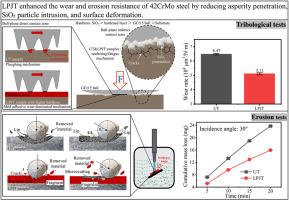Effect of laminar plasma jet surface hardening on the abrasive wear and erosion behavior of 42CrMo steel
IF 6.1
1区 工程技术
Q1 ENGINEERING, MECHANICAL
引用次数: 0
Abstract
To encounter the challenging service conditions in mining and oil and gas exploration, Laminar plasma jet (LPJ) surface hardening was applied to enhance the abrasive wear and erosion resistance of 42CrMo steel. Tribological performance was evaluated using ball-on-disc tests with SiO2 particles at the friction interface, while erosion resistance was tested under slurry immersion conditions. Surface morphological features and elemental composition were analyzed through scanning electron microscopy (SEM) and energy dispersive spectroscopy (EDS) to investigate the associated wear and erosion mechanisms. LPJ surface hardening produces a hardened layer composed of lath martensite, increasing the surface hardness to 1.89 times that of the untreated steel. As a result, the wear rate is reduced to 0.79 times that of the untreated sample, due to a shift in the wear mechanism in the ball-plane direct contact zone from an aggressive ploughing mechanism characteristic in two-body abrasive wear to a mild adhesive wear-dominated mechanism, potentially accompanied by localized oxidative wear. Additionally, erosion resistance is significantly improved due to the martensitic transformation of the surface microstructure, which offers higher yield strength and deformation resistance. This transformation alters the erosion mechanism from intense ductile erosion, which is characterized by extrusion and forging mechanism and ploughing mechanism, to a relatively mild brittle erosion, dominated by deformation mechanism and microcutting mode Ⅰ.

层流等离子体射流表面硬化对42CrMo钢磨料磨损和冲蚀行为的影响
针对矿山和油气勘探等复杂的使用条件,采用层流等离子体射流(Laminar plasma jet, LPJ)表面硬化技术提高42CrMo钢的耐磨性和耐蚀性。摩擦学性能通过摩擦界面上含有SiO2颗粒的球盘测试来评估,而在泥浆浸泡条件下测试抗冲蚀性能。通过扫描电镜(SEM)和能谱分析(EDS)分析了表面形貌特征和元素组成,探讨了相关的磨损和侵蚀机制。LPJ表面硬化产生板条马氏体组成的硬化层,使表面硬度达到未处理钢的1.89倍。结果,磨损率降低到未处理样品的0.79倍,这是由于球平面直接接触区的磨损机制发生了变化,从两体磨料磨损的侵略性犁头机制转变为温和的粘附磨损主导机制,可能伴有局部氧化磨损。此外,由于表面组织的马氏体转变,抗侵蚀性能显著提高,具有更高的屈服强度和抗变形能力。这种转变使侵蚀机制从以挤压锻造机制和犁耕机制为特征的强烈韧性侵蚀转变为以变形机制和微切削模式为主导的相对温和的脆性侵蚀Ⅰ。
本文章由计算机程序翻译,如有差异,请以英文原文为准。
求助全文
约1分钟内获得全文
求助全文
来源期刊

Wear
工程技术-材料科学:综合
CiteScore
8.80
自引率
8.00%
发文量
280
审稿时长
47 days
期刊介绍:
Wear journal is dedicated to the advancement of basic and applied knowledge concerning the nature of wear of materials. Broadly, topics of interest range from development of fundamental understanding of the mechanisms of wear to innovative solutions to practical engineering problems. Authors of experimental studies are expected to comment on the repeatability of the data, and whenever possible, conduct multiple measurements under similar testing conditions. Further, Wear embraces the highest standards of professional ethics, and the detection of matching content, either in written or graphical form, from other publications by the current authors or by others, may result in rejection.
 求助内容:
求助内容: 应助结果提醒方式:
应助结果提醒方式:


